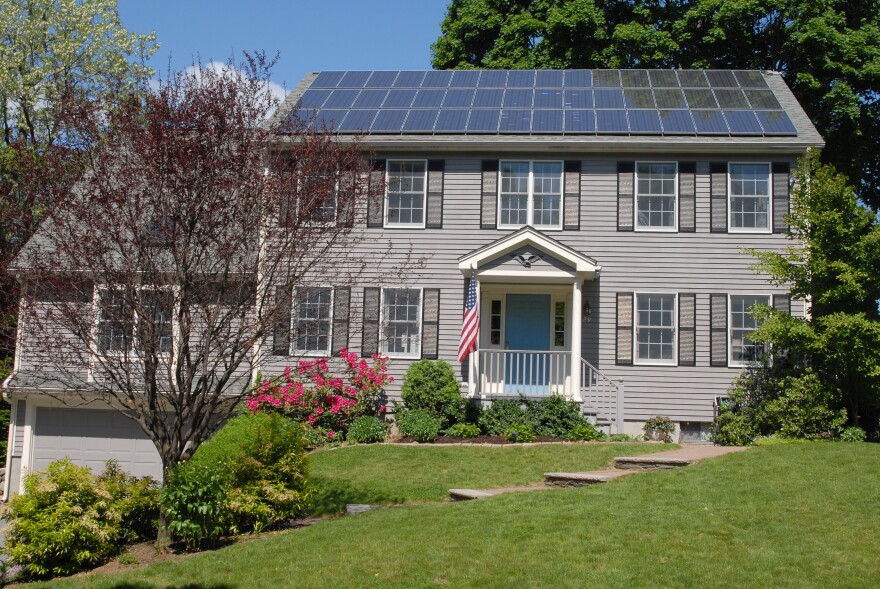Kentucky utility regulators have for the first time put a dollar figure to the electricity that rooftop solar customers generate when they put energy back on the grid.
They concluded that it’s worth a lot more than utilities want to pay net-metering customers.
The Public Service Commission set the net metering rate at a little more than 9 and a half cents per kilowatt hour. That’s less than the one-to-one retail rate Kentucky Power customers received previously, but more than twice the 3 and a half cents per kwh that Kentucky Power wanted to pay to solar generators.
Friday’s order from the Public Service Commission sets rates for rooftop solar customers in the eastern part of the state with Kentucky Power, but it also sets precedent for how utility regulators will determine the value of rooftop solar in the future.
“This order sets the paradigm under which customers will connect with the grid going forward,” said Matt Partymiller, president of Kentucky’s Solar Industries Association. “But it’s also not a decision that will have us dancing in the street.”
The commission took into account the costs and some of the benefits that rooftop solar customers provide, including the avoided costs of carbon, distribution capacity and environmental compliance, according to the order.
It’s a big deal for the state’s nascent solar industry, and a blow to utilities that have long argued they should pay rooftop solar customers similar to what they pay for wholesale power.
“It was Kentucky Power’s intent to provide a fair and balanced approach for all customers, not just the net-metering customers. We are still reviewing the order to gain a better understanding of the path forward,” said Kentucky Power’s Vice President of External Affairs Cynthia Wiseman.
Utilities have called the extra cost of rooftop solar a “subsidy” paid for by the utility customers that don’t participate in net metering. However, Kentucky Power didn’t actually conduct its own study until regulators asked them to do it.
That study found that each of its 165,415 non-net metered customers paid an extra 24 cents per year as a result of net metering, according to the order. The commission compared that to nearly $32 million that other customer classes pay in subsidies to the non-net metered residential customer class.
“The Commission raises this issue not as a basis for our decision, but to place the cost impact and Kentucky Power’s basis for proposing a new net metering rate into a larger context,” according to the order.
The Future of Solar
The state’s solar industry makes up fewer than 1% of all the peak load capacity at any of the state’s power companies. For it to keep growing, the president of the state’s Solar Industries Association said, rooftop solar needs to be able to show customers a return on their investment.
“Had the utility rates been accepted, that payback period [for net-metering customers] would have been 30 to 40 years out,” Partymiller said.
The order is the first of many to come from the Public Service Commission since the state legislature passed a law in 2019 requiring the commission to determine rooftop solar credits.
Each utility can propose a new rate for net-metering customers, and Kentucky Power was the first to apply — and therefore, it served as the first test case. Other utilities, including Louisville Gas & Electric and Kentucky Utilities, have net metering rates pending with the commission in the coming months.
The commission’s decision affects Kentucky Power customers who purchase solar panels or other forms of distributed generation after the order was issued on May 15. Kentucky Power customers who purchase solar panels now are guaranteed the current rate for the next 25 years.
Net-metering customers who already had service before January will continue to receive the 11-cent retail rate for the next 25 years.
Solar In Eastern Kentucky
Last June, Kentucky Power applied for a rate increase that would raise the average homeowner’s bill by about 16%, in part, to offset the same economic pressures its customers are feeling from the slow demise of the region’s coal industry.
Kentucky Power’s service territory includes 20 counties in Eastern Kentucky — all of which the Appalachian Regional Commission considers economically distressed or at-risk. The region’s decline has left the utility with fewer customers to help recover its fixed costs — maintaining electricity lines, poles, transformers and two aging coal-power plants.
Mountain Association commercial energy specialist Joshua Bills said rooftop solar offers an opportunity to small and mid-sized businesses in the region to help offset the rising costs of electricity.
The Mountain Association finances loans to help businesses invest in energy efficiency and distributed energy generation, including solar panels. In the last two years, it’s financed about $1.5 million in commercials solar for small businesses, Bills said.
But Bills said the future of rooftop solar in the region has more to offer than just cheaper electricity — growth of the industry can bring jobs.
“There’s a real opportunity for employment in a place that could really use some work,” Bills said.






